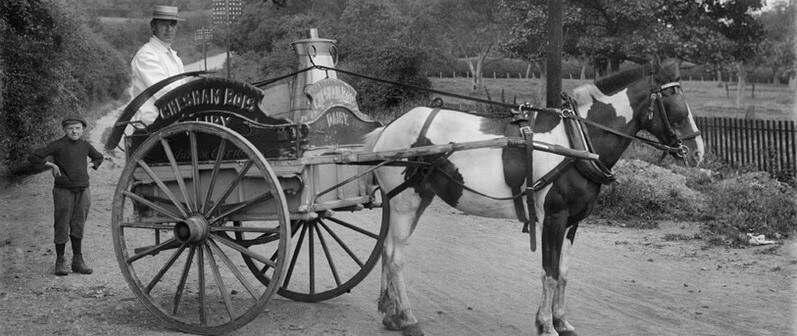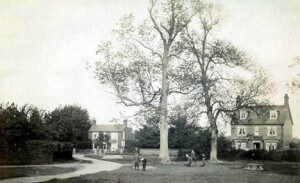
This page was written by Alison Bailey, who co-ordinates a group preparing articles relating to the history of Chesham Bois for this site
The arrival of the railway to Chesham in 1889 and Amersham in 1892 had bought rapid change to the area. There was a property boom, with a lot of new homes being built around the Common and the new road between Amersham and Chesham. Farm land had been auctioned for building plots with the Manor Estate sale taking place in 1896 and Bois Farm sale in 1903. Landowners such as Arthur Lazenby Liberty, John William Garrett-Pegge and John Hailey Morten had made large profits. Architects Kemp & How and John Harold Kennard and builders such as William Gomm & and George Pearce were all incredibly busy with building projects in Chesham Bois and Amersham-on-the-Hill. The air in Chesham Bois was marketed as ‘salubrious and bracing’.
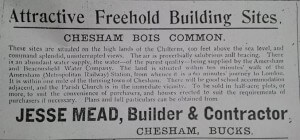
The Chesham Examiner, Amersham and Rickmansworth Times September 29 1905
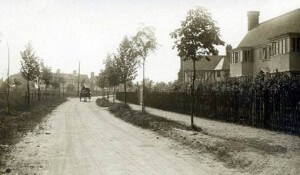
Nevertheless Chesham Bois was still a predominantly rural area. The parish was much larger than it is today, extending down to the river Chess until the 1934 boundary change, with the majority of parishioners living in the new Victorian terraces along Bois Moor Road. These ‘artisan dwellings’ built for railway workers also housed people working in the local mills and small factories (Chesham was known for its trade in beer, boots and brushes) and life in general was hard. “Many of the properties were almost hovels with no running water. People had to fetch drinking water from wells, and washing water from tanks containing roof water, while catch-pits collected household waste and sewage” (p30 “A Celebration of Chesham Bois” by the Parish Map Group). Watercress growing was a major employer with at times around 20 workers engaged in growing, picking and packing. The women and often the children worked in the traditional cottage industry of straw plaiting, making plaits for the hat trade. This had replaced the earlier craft of lace making which was no longer economically viable following changes in fashion and the introduction of machine made lace.

The Lower Bois area had the mills, 3 shops, including a fish and chip shop and a post office, a farm, a wood yard, cattle yard and a pub. The Unicorn was the only public house in Chesham Bois and it was only half a pub at that as the front room was in Chesham Bois and the back rooms in Chesham. It had been built in 1889 to replace an earlier building and was to have been called the Railway Hotel as the Metropolitan Railway Company’s original plans were to put the Chesham terminus on the Moor, next to the Unicorn. Instead the people of Chesham raised the money through public subscription to extend the line to the centre of the town. The Unicorn closed in the late 1990s and became a children’s nursery.

In the early 1900s Chesham Bois Common was much more open with few large trees. Animals still grazed there and it was mainly covered with gorse and bracken. There were very few gravelled or metalled roads before the War. Most roads were little more than muddy tracks lit at junctions by the odd gas lamp. Regular heavy wagon loads of cut timber passed up through the village and empty wagons were taken straight through Bricky Pond to give thirsty horses some water. After many complaints that the Common was being cut up by heavy carts new roads were built either side of the Common (now North and South Road) through local subscription. £200 was raised by 42 residents, organised by Henrietta Busk, who lived at Bois Cottage just north of the Common and the scheme was given a “send-off” when local dignitaries attended a ceremony “to turn the first sod”. “The Chesham Bois Troop of Boy Scouts attended under Assistant Scoutmaster M. Beckley, with their banner, and added colour and picturesqueness to the ceremony” (Bucks Examiner report July 8th 1910). (Click here to see a 1920 aerial photo which shows North and South Road built and the Common still largely without trees.)

1st Chesham Bois Scout Troop, who are entitled to wear the movement’s original scout green scarf, was the second scout group formed in Buckinghamshire. Inspired by Sir Robert Baden Powell’s newly published book ‘Scouting for Boys’, it was started in 1908 by the Woodcock brothers and their friends who met under the Punch Tree at the end of South Road. The tree got its name from its distinctive shape in the form of Punch’s head but was felled in 2004 and commemorative benches were made which can be found by Bricky Pond and the Pioneer Hall. The first Scoutmaster was Alexander Woodcock, who held the warrant from 1910, but Fred Beckley was the Scoutmaster in 1914. Alexander’s brother Cecil and Fred Beckley were both killed in WWI as were 6 other scouts. The third Woodcock brother, John, was the father of Tony Woodcock, the benefactor of the Amersham Museum. The scouts became an integral part of village life, particularly during the World Wars.

Some residents commuted into London by train but travel locally was by foot, horse and trap, or bicycle, with motor cars still extremely rare. People shopped for food daily and mainly ate what was grown on local farms. At this time Upper Bois had a few shops, such as Coles the Grocers, a post office in the newly built Anne’s Corner. More shops could be found in the newly developed Amersham-on-the-Hill.
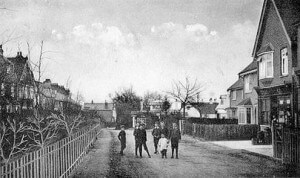
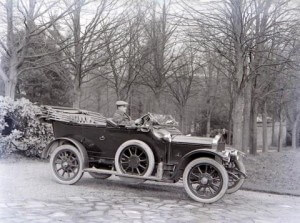
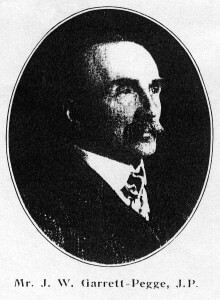 The Lord of the Manor was based in the village for first time since 1730s as John William Garrett-Pegge had bought the land and title in 1903 and changed the name of his house at the bottom of Amersham Road from Chesham House to Chesham Bois Manor. However life still centred round the church, particularly St Leonard’s which had been expanded in 1911 (again paid by local subscription) from 105 seats to 250. The Rector at the time was Thomas Fitzpatrick.
The Lord of the Manor was based in the village for first time since 1730s as John William Garrett-Pegge had bought the land and title in 1903 and changed the name of his house at the bottom of Amersham Road from Chesham House to Chesham Bois Manor. However life still centred round the church, particularly St Leonard’s which had been expanded in 1911 (again paid by local subscription) from 105 seats to 250. The Rector at the time was Thomas Fitzpatrick.
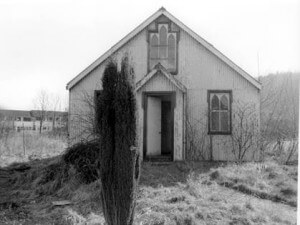
The Parish Council was founded in 1894 and was very closely linked with the church. The first meeting was held in the Mission Hall in Bois Moor Road (demolished in the early 1970s), 6 of the original 7 Councillors were from Lower Bois. Councillors such as Robert Beckley, of Cressbed Villa, were church wardens. John Birch of Leazefield House. Bois Lane (demolished in 1975 and replaced by flats) was the Clerk at this time and had been church sexton since 1869. Quite a character he had been a Parish Constable and “active in suppressing gambling on the Common”. He was a staunch teetotaller and strongly opposed to a pub in the village, which is perhaps why we only had half a pub at this time and don’t have a pub at all today.
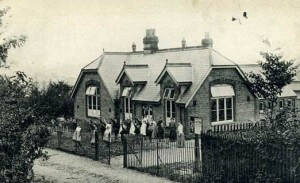
Chesham Bois School moved to the current building in 1894 after £1,202.2s.7d was raised by local subscription and Lord Chesham had donated the land in Bois Lane. It was initially called St Leonard’s Day School, as it took in both infants and juniors. Epidemics such as measles or scarlet fever were common and could close the school for up to 3 weeks.
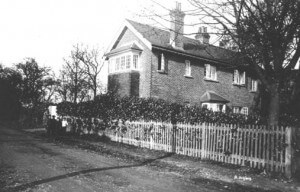
The private school, Heatherton House was founded in 1912 by Miss Edith Harrison and Miss Ysolde Walters. “In 1912 Miss Harrison and I walked up from the station with no houses on our left and just a few on our right! The hedges were covered in wild roses, and we crossed a gorse covered common. The next morning we set out with a list of houses which were for sale, and decided on Dr Mackenzie’s country cottage of eight rooms, with a garden large enough for a school to be built alongside his tennis court. In the autumn we opened our school with twenty children – boys and girls, who were taught in the dining room and the bedroom over it. Afterwards we started to build the school”. (From the ‘Memories of Miss Walters’ “Heatherton 100 Years of History”).
The railway and the new houses brought many newcomers to the village such as the Richardson sisters, Miss Porter and the Paynes of Orchard House. Tenant farmers from Hirons Farm, which had been sold by the Tyrwhitt-Drake family for the railway and the development of Amersham-on-the-Hill, the Paynes had money to spend and built three houses around the Common and Bois Lane as boarding houses. Visitors from London were also looking for property for weekend or holiday homes. Advertisements in the Bucks Examiner of July 1912 show the following prices “5 Cottages and small shop producing £74 2s per annum price £1050. Detached house 2 reception rooms 3 bedrooms stable ½ acre garden rent £38 price £650”. This influx did lead to conflict between long term residents and incomers. The Bucks Examiner of March 11th 1910 reports on a “lively discussion” at a meeting to discuss ‘improvements’ to the village. In the opinion of Mr Marston Morgan “there was not so much need for improvement of Chesham Bois. People who came there from London should conform to the country customs (applause) and put up with country methods and conditions. (Applause). They could not expect to find the beauties of Chesham Bois in London. (Applause). He never saw such a namby-pamby lot of people as they has had down there of late. (Laughter). They were afraid of a little mud because they might get their boots dirty as they went to the station. Surely they could get their boots cleaned when they arrived in London”.
The traffic wasn’t all one way though. The Bucks Examiner of 31st May 1907 uses the headline “Flowers to Bermondsey” to describe “a scheme for sending fresh flowers from the neighbourhood to very poor people in Bermondsey” which “has been set on foot by Lady Susan Truman, and the Rev T H Fitzpatrick records in the Bois Church Magazine that the wife of Canon Lewis has sent hearty thanks for the splendid supply of flowers from Chesham Bois”.
Women still didn’t have the right to vote but again things were changing. July 1913 saw the march of the National Women’s Suffrage Pilgrimage through the county. Henrietta Busk of Bois Cottage, a formidable pioneer of women’s education, and particularly Bedford College, was elected to Amersham Board of Guardians and Rural District Council in 1910 (it was1924 before Chesham Bois had its first woman councillor, Mrs Winifred Mary Jones). Down in the valley Chesham had a very active Suffragette movement (link to Walking with Buckinghamshire Suffragettes). Louise Jopling, the Artist and Suffragette, first came out to Chesham Bois at this time and the Labour politician Ramsey McDonald (later the first Labour Prime Minister) and his wife Margaret, rented Lindfield in Bois Lane (next door to Ten Point) as their family’s weekend home in 1905. Margaret who died in 1911 was a social reformer and had met Ramsey MacDonald through her work on the Women’s Industrial Council. She also served on the National Union of Women’s Suffrage Societies, although she was opposed to militant action.
“Shortly after we married she found that the world was to claim much time from both of us, and she considered schemes for defeating the world in its demands. At length she hit upon the idea of a week-end cottage. She was fond of walking, of starting in the morning and roaming all day through wood and field until the evening brought her home; and in March 1905 we pitched upon a small place at Chesham Bois by a delightful common and in the centre of innumerable field-paths and by-ways amongst the Chilterns. In every season, in fine weather and in bad, we roamed over the countryside from Northwood to Aylesbury, from the Thames to the hills beyond Tring, a land rich in historical memories and favoured by the affectionate care of Nature. She brought her friends there, and when not down ourselves she always tried to get someone else to go, that haply the blessings we had there might visit them too.
It was a land of majestic solemnity and magnificent romance, haunted by the shades of those who stood for the best in the life of England Cromwell, Milton, Hampden, Penn, Burke.” (From “Margaret Ethel Macdonald” by James Ramsey Macdonald.)

